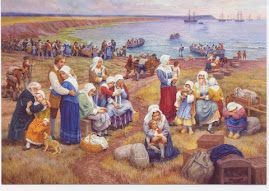
Port-la - Joye-Fort Amherst, National Historic Site of Canada.
Designated a national historic site in 1967, Port- la - Joye--Fort Amherst
Is part of one of the largest systems of national parks and national historic sites in the world.
Located on route 19 near Rocky Point, Prince Edward Island,
Port-la Joye-Fort Amherst is a special place because of the important role the site played in the colonization and growth of Prince Edward Island
European settlement of Prince Edward Island, then called Isle Saint Jean, began in 1720 and was marked by the conflict between France and Great Britain, for control of North America, while Aboriginal occupation and use date back thousand of
Years.
Three cultures played a role at this site, French, British, and Mi'Kmaq, The conflicts and alliances set the stage for what Prince Edward Island was to become.
PORT-la-JOYE.
In August of 1720 three ships owned by the Compagnie de l'Isle Saint Jean and carrying 300 passenger, arrived at Isle Saint Jean. These travellers began the construction of one of the Island's first permanent European settlement at Port-la-Joye.
Immediately after, Michel Hache dit Gallant came from Beaubassin to Port la Joye with his family, becoming one of the first Acadian families to settle on Isle Saint Jean.
Officials of the Compagnie hoped the efforts of these and other settlers would produce a thriving agricultural community capable of supplying French centres such as Louisbourg.
Port la Joye's first inhabitants erected suitable structures to accomodate the garrison and civil authorities - such as a chapel, store-house, bakery, forge, powder magazine, barracks and the commandant's lodgings.
Michel Hache dit Gallant established himself between the French outpost and the creek flowing into the cove. That area developed as the core of the Port la Joye civilian community.
Remnants of a building were uncovered in an archaeological dig and the site is marked with an interpretive panel.
Along with settlers who arrived to colonize the Island, came fishermen to take part in the aready established lucrative fishing industry.
The fisherman continued along the North-East River, ( Today the Hillsborough Heritage River ) to Havre Saint Pierre, named after the patron saint of the founder of the Compagnie de l'Isle Saint Jean, the Compte de Saint Pierre, The North-East River became the main waterway connecting Port la Joye to Havre Saint Pierre, ( later known as Saint-Pierre-du-Nord)
To be continued.


No comments:
Post a Comment